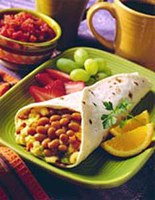Prairie Fare: Are Vegetarian Diets Healthful?
(Click an image below to view a high-resolution image that can be downloaded)
By Julie Garden-Robinson, Food and Nutrition Specialist
NDSU Extension Service
“Do you want to have lunch with me?” I asked my son. “They’re serving pork burritos, chips and salsa, a salad and dessert.”
“What are the other options?” my son asked.
This was odd. When does a 22-year-old guy turn down a free lunch? I know he likes the foods on the menu.
“Sorry, it’s a set menu with no other options,” I said. “Would you rather go to another place?”
We went somewhere else and he had a grilled cheese sandwich and tomato soup.
“I suppose I should tell you that I’m eating vegetarian several days a week,” he said. “Lots of people at work are on a vegetarian or vegan diet.”
I tried not to act surprised. In full disclosure, he was raised on a diet that did not restrict any type of food, whether animal or vegetable.
He wasn’t always my best vegetable eater, so this was a new twist. However, I figured he was old enough to make his own food decisions.
He did not stick to his new eating plan very long. A couple of weeks later, we had lunch again, and he grinned at me and ordered a Philly cheesesteak sandwich.
The popularity of vegetarian diets has increased, as have vegetarian options on restaurant menus and in supermarkets. Vegetarian diets usually are lower in fat and saturated fat. Some studies have shown lower blood cholesterol levels, lower risk of obesity and lower blood pressure among those following a vegetarian diet.
However, a well-chosen diet containing meat and other animal products is a healthful diet, too. A vegetarian diet with poor food choices is not healthful in the long run. Regardless of our personal food choices, we all need a variety of foods in moderation to maintain our health.
By definition, a vegetarian is a person who does not eat meat and, sometimes, other animal products. People choose to be vegetarian because of religious or cultural beliefs, specific health reasons or personal taste preferences, or for other reasons.
Several different categories of vegetarianism exist. A person following a “lacto-vegetarian” diet consumes dairy products but does not eat meat or eggs. Someone following a “lacto-ovo-vegetarian” diet consumes dairy products and eggs but does not eat other kinds of animal products. A person on a “pescatarian” diet does not consume any animal product except for fish.
Someone following a “vegan” diet does not eat any type of animal product. People following a vegan diet must plan carefully to avoid the risk of shortfalls in protein, vitamins and minerals.
For example, men ages 31 to 50 need about 6 ounce equivalents of protein-rich foods per day to meet their protein needs. To meet the 6-ounce goal on a meat-containing diet, that could mean 3 ounces of meat, one egg, 1 tablespoon of peanut butter and 1/4 cup of cooked beans throughout the day, according to the U.S. Department of Agriculture’s MyPlate plan.
On a vegan diet, protein can be a concern unless protein-rich foods such as cooked beans, lentils, peas, nuts and soy are consumed. The old rule was to combine complementary proteins (such as rice and beans) in the same meal to get all the essential amino acids. You no longer need to combine these foods in the same meal, according to current recommendations.
Eating at least some animal products, such as eggs and milk, helps prevent nutrient deficiencies among those who follow a lacto-ovo-vegetarian diet. For example, vitamin B-12 is found only in animal sources such as eggs and milk naturally, but it can be obtained through fortified cereal products.
“Fortified” means that the vitamin or mineral is added to foods that didn’t originally contain that nutrient.
Vitamin D is found in fatty fish, egg yolks and fortified dairy products. Dietary supplements might be needed, especially for those of us who get little exposure to sunlight during parts of the year.
However, if milk is not consumed, then calcium-fortified beverages (such as soy milk) and cereals and dark green leafy vegetables, such as broccoli, spinach and kale, can serve as calcium sources. However, calcium from cow’s milk typically is better absorbed than that from fortified foods.
Zinc also can be a concern when following a vegetarian or vegan diet. Chickpeas, beans, zinc-fortified breakfast cereals, wheat germ, nuts and pumpkin seeds are good sources. However, lacto-vegetarians get zinc from the dairy products they consume.
See the U.S. Department of Agriculture’s MyPlate vegetarian information at http://www.choosemyplate.gov/tips-vegetarians if you want to learn more.
Here’s a fiber-rich recipe courtesy of the Canned Food Alliance at http://www.mealtime.org that can fit in a lacto-ovo-vegetarian diet if you remove the bacon and choose vegetarian-style beans.
Breakfast Egg and Bean Burritos
1 (16-ounce) can smoky baked beans
6 large eggs
Freshly ground pepper, to taste
1 Tbsp. butter or margarine
6 strips cooked bacon, crumbled (optional)
1/3 c. chopped green onions
6 (7- to 8-inch) flour tortillas, warmed
1/2 c. shredded cheddar cheese
Salsa (optional)
Heat the beans in a small saucepan until heated through; keep warm. In a medium bowl, beat the eggs with salt and pepper. Melt the butter or margarine in a 10-inch, nonstick skillet over medium heat. Add the eggs and sprinkle with the bacon, if desired, and green onions. Cook, stirring occasionally, until the eggs are cooked. Divide the egg mixture into six parts and spoon one part into each tortilla. Top each with 1/4 cup beans and 1 Tbsp. plus 1 tsp. cheese. Fold in the ends and roll up the burritos. Top with fresh or canned salsa, if desired.
Makes six servings. Each serving has 380 calories, 16 grams (g) fat, 19 g protein, 42 g carbohydrate, 3 g fiber and 970 milligrams sodium.
(Julie Garden-Robinson, Ph.D., R.D., L.R.D., is a North Dakota State University Extension Service food and nutrition specialist and professor in the Department of Health, Nutrition and Exercise Sciences. Follow her on Twitter @jgardenrobinson)
NDSU Agriculture Communication - March 15, 2018
| Source: | Julie Garden-Robinson, 701-231-7187, julie.garden-robinson@ndsu.edu |
|---|---|
| Editor: | Ellen Crawford, 701-231-5391, ellen.crawford@ndsu.edu |



